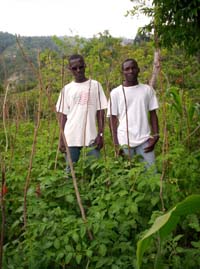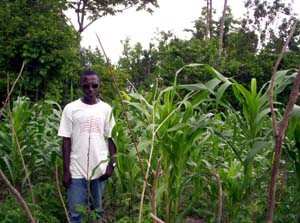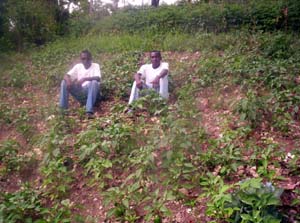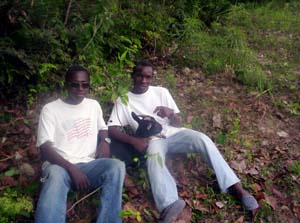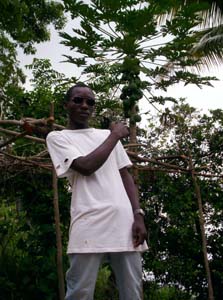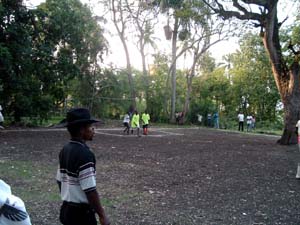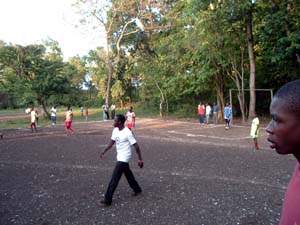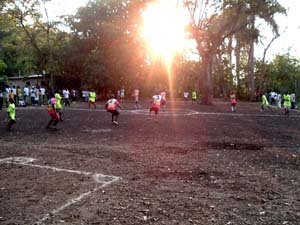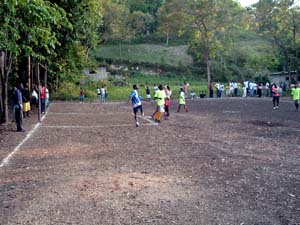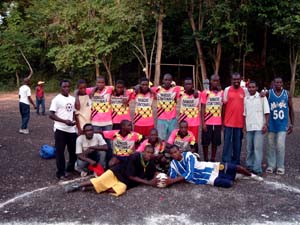I was talking to Milienne Angervil, the Matènwa school’s wonderful second grade teacher. I’ve written of her work before. (See: StartingWhereTheyAre.) I hadn’t seen her in awhile, so we were catching up. She had recently missed about a week of school, and was telling me about returning to her class. One of the days she missed was the day I spent with the school’s sixth graders, so I was explaining to her how that went.
I told her about the problems I felt I had directing the class. I lacked even the minimal control that I thought I was expected to maintain. We got through the day, and did some good work, but it was more chaotic and louder than it should have been.
Milienne found my troubles funny. I said what I’ve told her before: Sixth graders were hard enough; I cannot remotely imagine taking a group of second graders for a day, much less for a year.
She answered that the younger they are, the better she likes them. She likes to see their progress, and she gave me a clear example. In the two weeks since she had returned to school, her kids had learned to leave spaces between the words when they write sentences. It had been sudden, dramatic progress that spread like a wave through her class. Everyone had learned at once. Except Ronaldo, who still refuses to leave spaces. He says, she explained, that he’ll use up his notebook too quickly, and she accepts his reasoning, at least for now.
Milienne’s words pushed me to consider the groups I work with. Some of my work involves planning, program design, and the like. But there are groups I lead or co-lead directly. I decided to ask myself whether I could report the kind of clear, concrete progress Milienne could. The answer turns out to be as varying as the groups themselves are.
The first group I need to talk about is the Kofaviv group, the victims of rape who have become community organizers, helping new victims find health and other support services. I want to take it up first, because we’ve been working together for a relatively long time: almost weekly for about a year. Several of their lead members had been part of a Wonn Refleksyon group a couple of years ago, and they had decided that it was important for all the field workers to learn how to use Wonn Refleksyon to lead groups.
We went straight through the first volume of texts, and then decided to take on the second volume. These texts are much more difficult, or at least more alienating. For example, they include simple, but technical texts in math and science. Various otherwise-successful groups in Haiti had been consistently shying away from them.
The women were not at all put off by these challenges. In fact, they have barely taken note of them. But this is for a very simple reason: They consistently find some angle in the text that relates to their experience, and they take their departure from it. For example, when we read a text from a Richard Dedekind book on number theory, it became the occasion for a discussion of arithmetic skills, why some educated members can manage numbers while their illiterate mothers, sisters, and aunts handle them with ease.
There’s nothing wrong with that. In fact, it’s very much what the texts were designed to do: give group members a way to raise and address issues important to their lives. There is, after all, no particular reason for the women to study number theory.
At the same time, I felt that the women were ready to make greater use of the texts. The texts can do more than just suggest topics that are important to us. They can give us a way to face them, a tool that furthers our shared inquiry. For example, the Dedekind text suggests a way to understand what arithmetic is and where it comes from. Specifically, it suggests that it’s a series of tools we human create. That challenging claim might be able to help us think about why some of us take to math more easily than others, and why it has little to do with our level of formal education, if, that is, we let it help us.
To let a text do more than suggest a line of inquiry means returning to its puzzles in the midst of our dialogue, to see how they might relate to the questions that interest. This is something the Kofaviv women are not yet inclined to do. Once they hit upon the issue that they want to focus on, they’re off to the races. They’re unlikely to look at the text again.
So I’ve been trying to wrestle with this. I’ve been trying to help them look harder, and more often at the words on the page in front of us. I’ve lead a couple of our meetings personally over the last few weeks, temporarily turning away, with their encouragement, from their routine, which is for them to take turns leading the group. It’s too early to say whether it’s having an effect. But a couple of weeks ago, we spent 90 minutes going line by line through a series of definitions from a geometry text, and when we were finished, they asked to spend a second week the same way. So the least I can say is that they are enjoying our shared effort.
Another of the groups I work with directly is the collection of guys I meet with in Cité Soleil. They are not yet organized in any official sense, though that may change soon. We still meet together as frequently as I can. Since I am increasingly spending nights in my room down there, the same room we meet in, it means we can have several hours together each week.
The experience is very much a new direction for me. The guys and I want to achieve something more than learning to learn together. Though Wonn Refleksyon plays an important role in our collaboration, it cannot be the core of it. There is, for one thing, their desire to learn English. They have been working hard, mainly with Héguel, but also with me, and some of them are improving quickly. Five or six of them speak pretty well, even though their experience of the language is still limited. I had to laugh the other day when Jimmy told one of the other guys, “If you don’t sing with me, I will beat you up.” It was clear as a bell, and though I would worry about the sentiment if I took it literally, the giggle in his voice made it perfectly clear that he was just having fun.
But what we’re really trying to achieve together is a transformation in the way they see and, eventually, live their lives. The centerpiece of this project is a business we’re trying to establish making and selling inexpensive solar power chargers for cell phones. In addition to all the external barriers to such an initiative – among other things: securing needed materials and start-up capital and getting the training we’ll need – there are internal barriers as well: the group needs a clear structure with transparent ways to make decisions. And these must be in writing. The group needs some kind of charter in order for it to open the little bank account that getting started will require. They have already decided that they do not want to leave group money in any individual’s hands, not even as an interim measure.
What has impressed me recently is the clarity and the patience with which the group is discussing these sometimes-complex questions. They are listening to one another and deciding things together, making real efforts to leave no one behind. Just a few months ago, two or three of them were simply shouting one another down, and that in a discussion of a folktale about two mice, some cheese, and a clever but sleazy monkey-judge. Though things will get harder when money, and therefore competing personal interests, enter the scene, for now, I am hopeful.
The last group I want to mention is really two very different groups. It is two sets of employees of the large Irish NGO, Concern Worldwide. One of them, on Lagonav, is close to the beginning of their experience of Wonn Refleksyon. The other, at its Petyonvil main office, is much farther along.
The Lagonav group has been struggling. That’s the main reason I was invited to join them. Its main leaders have been Milienne and Abner. Much of Concern’s Lagonav staff has been reluctant to invest itself too heavily in the process. They don’t yet see the point. Some, however, have been quite engaged. I was sitting with them for the first time.
The group has a lot of work to do. It consists of a wide range of staff members. Predominantly men, there are a few women. It includes engineers, community organizers, administrative, security, and custodial staff, and drivers. Though almost everyone participated in some way – whether just in the small group work or by speaking up, as many did, in the large group discussion – that discussion was very much dominated by three men, all of them higher-level staff.
Strangely enough, I think part of this has to do with the shape of the room we met in. It’s relatively long and narrow for the size of the group. So we sat in what became a thinnish rectangle, rather than in a circle. The two most dominant figures sat in the center of one of the long sides of the rectangle. The other sat in the middle of one of the short sides. I sat opposite him, on the floor. There wasn’t room for enough chairs. The arrangement left spaces in the corners where three or four participants we crowded in a way that very much seemed to take them out of the discussion. It was much easier for them to whisper to a neighbor. They couldn’t always see the face of the person talking, nor could they always be seen.
The constraints of the meeting place weren’t the only problem, however. There are problems in what I would call some participants’ “interest in listening” that the group will have to face. These problems were most evident at two moments.
At one point, a custodian quickly and quietly made a short contribution that he punctuated by saying “That’s what I think” before returning to silence. His remarks were greeting with derision by some of the other men, who patronizingly called him “doctor” after laughing audibly as he spoke. At another point, one of the dominant members made a long and loud point. When I asked what others in the group thought, he asserted, again loudly, that they agree, quoting a French saying that silence implies agreement. I told him he was nuts if he thought that silence in a conversation truly implies agreement, and there was uncomfortable laughter. The words I used were a little harsh.
Both these instances show how far the group is from knowing how to talk together. At this point, it’s not even clear that they want to talk together. But, if we can help them see what they have to gain from listening and help them then learn the patience they’ll need to do so, they will have gained a lot.
The Petyonvil Concern group is at another point of its development entirely. They have been meeting almost every week for over two months, and the consistency of their work is starting to pay off. Within the first few weeks, members of the group were making the space necessary to allow as many as possible to speaking, but more and more, they are now listening to each other, responding to each other. Rather than just politely taking turns – itself an important step – they are starting to work with the ideas that participants put forth.
At the same time, the group has divided itself ever more clearly into two subgroups. One subgroup participates every, or almost every, week, showing upon time almost on time to each of the sessions. The other is increasingly casual about the meetings, often missing meetings entirely. Its members simply aren’t sold on the value of the process.
I led the group personally last week, and I made a point of emphasizing Concern’s goals for the process, the reasons that Concern’s leadership had invited us to work with them. There are two: On one hand, they want to improve the quality of communication within the organization, especially between people who are at different places in the hierarchy, and, on the other, the want staff members who work in the field with grass roots organizations to learn a new way to lead meetings.
Then I talk just a little about the Wonn Refleksyon process generally. I said that there are two very different ways to express its fundamental goal. Usually, we frame that goal in terms of what we want for the group. We say that we want groups to learn how to share authority and responsibility equally among their members.
But there is another way to frame the same goal that takes individual progress as its starting-point. We can thus also say that we want each individual to be, as much as possible, both a leader of the group and a participant. I spoke a little about this second way of framing the goal, saying that a key part of achieving it is encouraging everyone to evaluate their own work as leader/participants. And so I asked members of the group to evaluate both themselves and the group.
That’s when things got interesting. The conversation became an attempt to figure out why some colleagues had been participating less and less in the activity. There was lots of interest in the question because those discussing it were a self-selected collection of folks who had already decided the activity was worth their time. But they wanted colleagues who had caught their enthusiasm to rejoin us.
The more we talked, the more urgent the question seemed to feel. When it became time for us to leave off evaluating ourselves and turn our attention to the week’s text for discussion, I asked whether they wanted to turn to the planned text or to keep working on the question before us, and the answer was clear. They wanted to keep talking about how they might improve the group. It was a kind of rebellion: They were not interested in turning to our planned activity until they had figured out the more important question they had on their minds.
And it led to a larger rebellion. The group decided that one of our problems is that some of their colleagues are thrown off by the texts we use. They might enjoy them – although some of them might not even do that – but the fact that the texts do not relate directly to their work has them thinking that the activity is, at best, supplementary, not really important for their work. I can be sure whether this is really the reason some people are dropping out of the activity, since the participants who have not been coming were, of course, not there to speak for themselves. But most of the folks who were at the meeting seemed convinced.
When I asked them to suggest texts that people would want to talk about, there were lots of very general suggestions – something about this, something about that – but, initially, nothing concrete.
Then I changed my tack. I asked whether anyone would volunteer to meet with me before the next meeting to look at possible texts and to plan how we would use one. I added that the volunteer would then co-lead the class with me. There was a prolonged silence. Eventually, I caught the eye of a member of the security staff named Ishmick. He had been vocal in expressing his opinion that the Wonn Refleksyon discussions are important, but also that they’re not catching on because too many people fail to see their importance. He had suggested a book we might find a text in – a kind of overall policy manual Concern works with – but didn’t name a text. When, however, I asked him outright whether he’d work with me, he cheerfully agreed.
So that’s where things stand: Ishmick and I must meet by Monday to talk through how we will lead the class. It’s nothing like anything I’ve done in Haiti. It’s like turning the asylum over to the inmates, as we like to say, but these inmates may know much better than I ever could just what course they need to take. And even if they don’t, they’ll probably learn more from experiencing the consequences of their intuition than they could ever learn from following mine. My job is to accompany them as they work things out. If I can help assure that they both evaluate their work explicitly and then act on their evaluations, they are certain to move forward.

